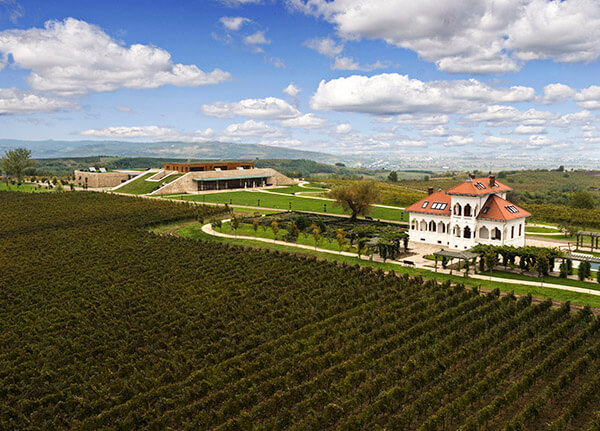
The winery and the vineyard

The AVINCIS winery, looking towards the future
The family manor, reconditioned by architect Alexandru Beldiman, maintains the Brâncovenesc style influences from the beginning of the 20th century, whereas the winery was designed as a ship situated at the top of the Dobrușa hill, perfectly integrated into the landscape, with its walls covered with Arnota limestone, with its lawn that goes up to the roof and the three wooden houses that delimit the terrace. The winery’s construction ensures the quality of the winemaking, since it was built so that it would take into account the imperatives of this process and the circulation of the flows through gravity. An underground access ramp and a wide tunnel enable optimal communication with the technical spaces.
The AVINCIS wines, an expression of the Dragasani terroir
Drăgășani has all the prerequisites of a registered designation, in the French fashion. The Drăgășani vineyard has always produced white wines that are fine, cool, with good acidity. The red wines from the region, produced chiefly from Cabernet Sauvignon and the local variety Negru de Drăgășani, also enjoy national and international appreciation.
Situated on the right bank of the Olt river, the largest tributary of the Danube in Romania, the Drăgășani vineyard extends over a length of 60 de km, between the Getic Sub Carpathians in the north and the Romanian plain in the south.
The dominant soil in the vineyard is clay, with traces of limestone, sand, gravel and marl. The vineyard’s climate is temperate continental, with Mediterranean influences, and its main characteristic is balance. Owing to its location along the Olt valley, which has a balancing role, the Drăgășani vineyard enjoys good humidity, even in the hottest months of the summer.
Thus, other varieties have been readapted to Drăgășani, as a result of rigorous work of grapevine improvement, at the Research Station for Viticulture and Winemaking, founded in the area in 1936.
Among the Romanian varieties, nowadays, Crâmpoșia Selecționată, Tămâioasa Românească, Feteasca Regală, Feteasca Albă, Negru de Drăgășani, Novac și Fetească Neagră are grown.
The grapevine, on the blessed hill
All the attention is given to the grapevine. Andrea Previtali, AVINCIS wine maker, together with the agronomist engineer Alin Balaban, devote all their energy to work the land by tilling between the rows and the grapevines, in order to eliminate the herbicides and synthetic fertilizers and in order to increase the interventions during the works done when the grapevine is green, thus allowing the grapevine to return the largest number of the soil’s characteristics. The wine’s traceability is absolute. Each parcel was identified with care and capitalized on.
From the first time you gaze upon it, the location of Vila Dobrușa, where the AVINCIS wines are produced, looks like a hill that was blessed by God. This vineyard that is adequate in size (43 hectares planted) takes up the entire hill and descends in gentle slopes towards the valleys. Sun exposure is outstanding, as the plateau absorbs the day’s first rays of sunshine and keeps the last ones.
The winemaking process
Productivity, between 35 and 45 hectoliters per hectare, depending on the parcel and on the harvesting during the period when the grapevine is green, is comparable to the one of the most demanding vineyards. The grapes are manually harvested, in small crates, near the winery - situated right in the center of the estate, so their immediate processing is ensured.
The winery is equipped with all the modern technological means, for the benefit of quality:
• an efficient system for the cooling of harvested grapes;
• micro-winemaking for each parcel;
• tender crushing of grapes in a pneumatic press;
• winemaking in controlled temperatures;
• climate control in the winery for optimal aging;
• loading into barrels manufactured in France.